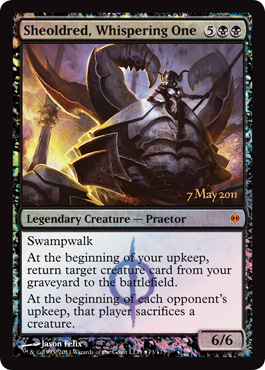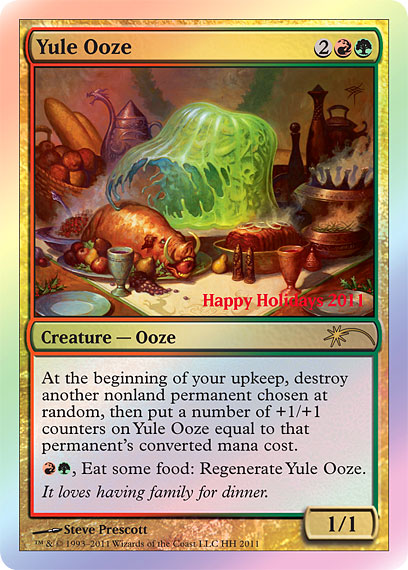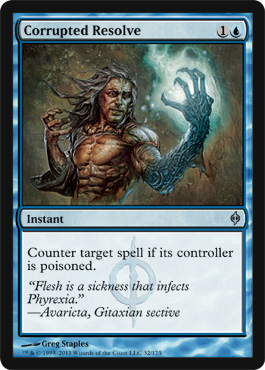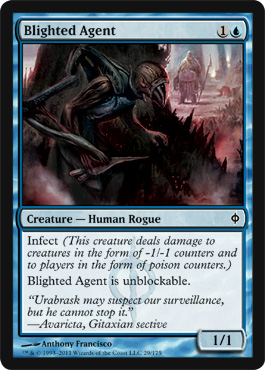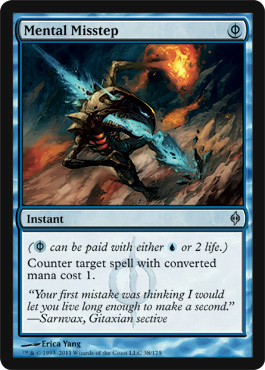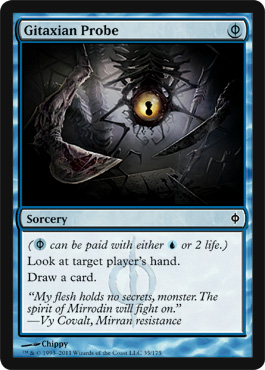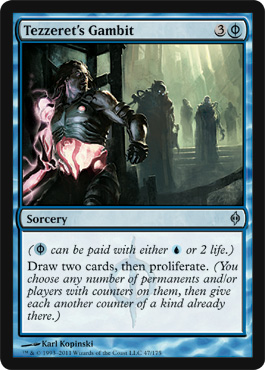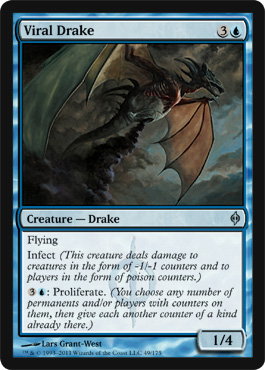Long time, no see, invisible audience! Today is a very special day, because, clearly, I'm writing again. About what, you ask? MAGIC! Of course!
Now, I used to have an article I wrote on another website detailing how to play Magic, but the website has been taken down, and with it the only archive of that particular work. So, in order to let people explore the game on their own time, I'm going to write a newer, up-to-date piece here. Let's begin, shall we?
The premise of the game is this: in the infinite bounds of the Multiverse, countless worlds exist. But only a few powerful mages and sorcerers have the ability to transverse the void between them. Planeswalkers. You are a Planeswalker. And you must assemble spells from the worlds you've traveled to and allies you've made to defeat other Planeswalkers!
Cool, huh? Yeah. But seriously, what is Magic: The Gathering?
Magic: The Gathering is the magnum opus of one Richard Garfield, a high school math teacher who designed and developed the game. Ultimately, he was awarded an Honorary Ph.D. in Combinatorial Mathematics by Pennsylvania State University for his efforts. But the real prize here is that Magic: The Gathering (or "MTG" as most of us call it colloquially; we will call it that for the rest of the article) is the first Trading Card Game. Everything else in the genre has spawned off this. What's even more impressive, is that MTG will be celebrating it's 20th Anniversary in August 2013.
In 1993, Wizards of the Coast was approached by Garfield to produce another game he was working on. He was turned down because Wizards didn't have the resources he required at the time. They did ask him to create a portable game for conventions and the like. And this is what we got. Alpha, the first MTG Set, was released that year. Now, you can find any of this anywhere else, specifically, Wikipedia. With much more detail, to boot. So that won't be the focus tonight. Here, I am going to attempt to explain the mechanics and parts of the game necessary to play it in a way that's personable and intuitive.
Setup: Each player starts with a deck of at least 60 cards and 20 Life. Each player shuffles their own deck, then cuts the opponent's deck. You then draw 7 cards. Through battle and spells, you can damage your opponent and make them loose life. If your life falls to 0 or less, you lose the game. The rest requires a bit of explanation.
This, is Canyon Minotaur. Impressive looking isn't he? I think so. Ok, so see all that stuff on the card? Yeah, it all means something. And at some point or another, it all matters. So the most obvious place to start is with the parts of the card.
Obviously, there's the name. Canyon Minotaur. Right there. See it? Good. Ok, now on the opposite side of that, in the top right corner, is the most important aspect of any card, period. Mana cost. This is how much mana you need to cast this monster. What does that mean? Well, it's actually a bit complex, but remarkably easy to grasp. Long-winded is what I'm getting at. So we'll come back to that. For right now, just keep in mind that he costs 3 and a Red.
Below the art, in that text bar, the first thing we see is "Creature" followed by a long dash. This is the Card Type. There are all in all, 6 types. They are:
After the dash, there are subtypes. He's a Minotaur Warrior. Each creature has at least one subtype for several reasons. Some have several. Some subtypes only appear on one or two cards. But they all have at least one.
Across from that, there is a little symbol. That's called the Expansion Symbol, telling us what set this card is printed in. This is important for Tournament play, where certain formats only allow cards from certain sets. To conserve design space and resources, thus ensuring years of MTG to come, cards are reprinted from older sets all the time. They may change rarity, but the card is the same.
The giant text box below that is the card description. This one only has what's called "flavor text". You see, Magic is built on stories, and the cards strive to tell and illustrate the stories of the planeswalkers and their journeys, as well as provide an entertaining game. This is something else that makes MTG special. Most cards have other things printed here though. Keywords, abilities, all sorts of things. I have to explain combat first, but know that most cards don't have just flavor text. The ones that do are called "vanilla" by players.
Now, there's that box in the corner. It has two numbers separated by a slash. This is called the "Power/Toughness" box. And you guessed it, the first one is power, the second one is toughness. Power is how much damage a creature deals during combat, and toughness is how much damage a creature can sustain before being destroyed.
All good? Good. now we can really start.
What's mana, though? From a flavor standpoint, it's the unique magical energy that flows from each world that mages use to cast their spells. There are five different colors of mana, and each comes from a different kind of land, and does certain things really well. White mana flows from grassy Plains and prairies. Blue mana seeps up from Islands and rivers and sea. Black mana seethes out decaying Swamps and bogs. Red mana erupts from the Mountains and rocks. And Green mana flowers from the lush Forests and gardens. But how does this work in game?
These are very pretty full-art land cards. Basic lands, specifically. Lands that you as a Planeswalker have bonded with and can "tap" for mana. You can play one land each turn (either basic or non-basic). To cast spells with them, you have to tap them, which is turning them sideways. Tapping a land gives you one mana of that color.
Remember that mana cost thing? This is it. You use lands to play other spells! So, remember, Canyon Minotaur costs 3 colorless and one Red mana. Now, colorless just means you can pay with any color of mana. The mana symbols can only be paid with that colored mana. So you would need to tap one Mountain, and any three other lands to play Canyon Minotaur.
Alright, you've been patient. Lets take a quick look at combat.
This is Centaur Courser. For the most part, Canyon Minotaur. Except that you may notice a few things different about him. For one, he's Green. And he only costs 2, plus a Green mana. Which makes him, by extension, Green. So let's say we make them fight.
Now, I used to have an article I wrote on another website detailing how to play Magic, but the website has been taken down, and with it the only archive of that particular work. So, in order to let people explore the game on their own time, I'm going to write a newer, up-to-date piece here. Let's begin, shall we?
The premise of the game is this: in the infinite bounds of the Multiverse, countless worlds exist. But only a few powerful mages and sorcerers have the ability to transverse the void between them. Planeswalkers. You are a Planeswalker. And you must assemble spells from the worlds you've traveled to and allies you've made to defeat other Planeswalkers!
Cool, huh? Yeah. But seriously, what is Magic: The Gathering?
Magic: The Gathering is the magnum opus of one Richard Garfield, a high school math teacher who designed and developed the game. Ultimately, he was awarded an Honorary Ph.D. in Combinatorial Mathematics by Pennsylvania State University for his efforts. But the real prize here is that Magic: The Gathering (or "MTG" as most of us call it colloquially; we will call it that for the rest of the article) is the first Trading Card Game. Everything else in the genre has spawned off this. What's even more impressive, is that MTG will be celebrating it's 20th Anniversary in August 2013.
In 1993, Wizards of the Coast was approached by Garfield to produce another game he was working on. He was turned down because Wizards didn't have the resources he required at the time. They did ask him to create a portable game for conventions and the like. And this is what we got. Alpha, the first MTG Set, was released that year. Now, you can find any of this anywhere else, specifically, Wikipedia. With much more detail, to boot. So that won't be the focus tonight. Here, I am going to attempt to explain the mechanics and parts of the game necessary to play it in a way that's personable and intuitive.
Setup: Each player starts with a deck of at least 60 cards and 20 Life. Each player shuffles their own deck, then cuts the opponent's deck. You then draw 7 cards. Through battle and spells, you can damage your opponent and make them loose life. If your life falls to 0 or less, you lose the game. The rest requires a bit of explanation.
Parts of a Card
This, is Canyon Minotaur. Impressive looking isn't he? I think so. Ok, so see all that stuff on the card? Yeah, it all means something. And at some point or another, it all matters. So the most obvious place to start is with the parts of the card.
Obviously, there's the name. Canyon Minotaur. Right there. See it? Good. Ok, now on the opposite side of that, in the top right corner, is the most important aspect of any card, period. Mana cost. This is how much mana you need to cast this monster. What does that mean? Well, it's actually a bit complex, but remarkably easy to grasp. Long-winded is what I'm getting at. So we'll come back to that. For right now, just keep in mind that he costs 3 and a Red.
Below the art, in that text bar, the first thing we see is "Creature" followed by a long dash. This is the Card Type. There are all in all, 6 types. They are:
- Creature
- Instant
- Sorcery
- Enchantment
- Artifact
- Planeswalker
After the dash, there are subtypes. He's a Minotaur Warrior. Each creature has at least one subtype for several reasons. Some have several. Some subtypes only appear on one or two cards. But they all have at least one.
Across from that, there is a little symbol. That's called the Expansion Symbol, telling us what set this card is printed in. This is important for Tournament play, where certain formats only allow cards from certain sets. To conserve design space and resources, thus ensuring years of MTG to come, cards are reprinted from older sets all the time. They may change rarity, but the card is the same.
The giant text box below that is the card description. This one only has what's called "flavor text". You see, Magic is built on stories, and the cards strive to tell and illustrate the stories of the planeswalkers and their journeys, as well as provide an entertaining game. This is something else that makes MTG special. Most cards have other things printed here though. Keywords, abilities, all sorts of things. I have to explain combat first, but know that most cards don't have just flavor text. The ones that do are called "vanilla" by players.
Now, there's that box in the corner. It has two numbers separated by a slash. This is called the "Power/Toughness" box. And you guessed it, the first one is power, the second one is toughness. Power is how much damage a creature deals during combat, and toughness is how much damage a creature can sustain before being destroyed.
All good? Good. now we can really start.
Mana and Lands
Mana is the core of the entire game, and thus is the most essential to know.What's mana, though? From a flavor standpoint, it's the unique magical energy that flows from each world that mages use to cast their spells. There are five different colors of mana, and each comes from a different kind of land, and does certain things really well. White mana flows from grassy Plains and prairies. Blue mana seeps up from Islands and rivers and sea. Black mana seethes out decaying Swamps and bogs. Red mana erupts from the Mountains and rocks. And Green mana flowers from the lush Forests and gardens. But how does this work in game?
These are very pretty full-art land cards. Basic lands, specifically. Lands that you as a Planeswalker have bonded with and can "tap" for mana. You can play one land each turn (either basic or non-basic). To cast spells with them, you have to tap them, which is turning them sideways. Tapping a land gives you one mana of that color.
Remember that mana cost thing? This is it. You use lands to play other spells! So, remember, Canyon Minotaur costs 3 colorless and one Red mana. Now, colorless just means you can pay with any color of mana. The mana symbols can only be paid with that colored mana. So you would need to tap one Mountain, and any three other lands to play Canyon Minotaur.
Combat
Alright, you've been patient. Lets take a quick look at combat.
This is Centaur Courser. For the most part, Canyon Minotaur. Except that you may notice a few things different about him. For one, he's Green. And he only costs 2, plus a Green mana. Which makes him, by extension, Green. So let's say we make them fight.
Here's how combat works:
Now here, I can make a choice. I can either declare one of my creatures to block yours, where combat will occur, or I can choose to just take it like a champ and eat the damage out of my life. But that's no fun. Nor is it helpful in a demonstration. So, I'll declare Canyon Minotaur as a blocker.- The active players (You) declares who is attacking the opponent. In multiplayer, you can attack as many opponents as you are able to.
- You tap Centaur Courser, attacking with him.
- Canyon Minotaur deals 3 damage to Centaur Courser, meeting the minimum amount to kill him.
- Centaur Courser also deals 3 damage to Canyon Minotaur, also meeting the minimum 3 to kill him.
- All damage is done at once, and both creatures are destroyed.
And that's combat! Now during combat, you can do all sorts of neat stuff like cast your Instants and activate abilities. There are also certain keywords like Indestructible, Flying, First Strike, and crazy shit like that. Don't worry, it'll all come in time.
Card Types
So we know what creatures are, But what about the other stuff? Here's a brief breakdown:
Sorcerys:
A Sorcery is a spell that has a one-time effect. It can be anything, like returning cards from one place to another, making your baddies bigger, or your opponents smaller, or even dealing direct damage to opponents! You can only cast them on your turn when nothing else is happening. So no combat tricks.
Instants:
Instants are just like Sorcerys, except that you can cast them at any time. Well, almost, but that's for another day! Actually, about a year ago. But never you mind that.
Enchantments:
Artifact cards are actually really crazy. They're almost always colorless, but they're all different. Some work like enchantments, some can tap for mana, some can be equipped to your creatures for boosts, and some are even Creatures as well! With a few exceptions, anyone can play any artifact cost, because you can use any color mana to cast them. Most do a good job of explaining themselves.
Planeswalkers:
Sorcerys:
A Sorcery is a spell that has a one-time effect. It can be anything, like returning cards from one place to another, making your baddies bigger, or your opponents smaller, or even dealing direct damage to opponents! You can only cast them on your turn when nothing else is happening. So no combat tricks.
Instants:
Instants are just like Sorcerys, except that you can cast them at any time. Well, almost, but that's for another day! Actually, about a year ago. But never you mind that.
Enchantments:
Enchantments are spells that stay on the field and have either a constant effect on something, or does something whenever something else happens. Some target specific creatures or lands, others do wild and crazy stuff that effect other spells you or your opponents play.
Artifacts:
Planeswalkers:
Planeswalkers are the newest card type, introduced back in 2008 with Lorwyn. They are allies you call to your aid to help you in battle! They can be played at anytime you can play a sorcery or creature. Now, they have a little number in the corner. Kinda like a P/T Box. Except there's only one number. This is called their Loyalty. If shows how many Loyalty Counters they come into play with. They also have a set of abilities (usually three, though there are exceptions) that either add or remove Loyalty counters and create an effect. You can use these "Loyalty Abilities" once per turn. They can be attacked, just like a player, and damage is dealt to their Loyalty, kinda like their "Life".
Planeswalkers are remarkably powerful on the field, and can if nothing else, take the heat off you while you prepare for something else.
So now you know the basics of Magic! If you find yourself particularly interested, there are a few places you can go! You can go to a local comic shop, and usually on Fridays they have Friday Night Magic, where a bunch of people come to play MTG with eachother and test the newest decks and refine their playing skills. Just pay a visit and see what's up. Chances are they play Standard, which is a format you can find out more on in my Format Primer a post or two back.
Good luck, future spellslingers!
Planeswalkers are remarkably powerful on the field, and can if nothing else, take the heat off you while you prepare for something else.
So now you know the basics of Magic! If you find yourself particularly interested, there are a few places you can go! You can go to a local comic shop, and usually on Fridays they have Friday Night Magic, where a bunch of people come to play MTG with eachother and test the newest decks and refine their playing skills. Just pay a visit and see what's up. Chances are they play Standard, which is a format you can find out more on in my Format Primer a post or two back.
Good luck, future spellslingers!





